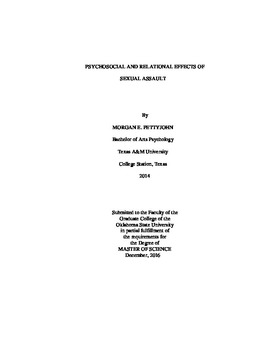| dc.description.abstract | The current study aimed to examine the effects of sexual assault on female survivors’ levels of psychosocial and relational distress, including more specific subscales of relational distress (cohesion, consensus, and satisfaction). Retrospective analyses were conducted on clinical data for 154 female clients who presented for couples therapy at a Marriage and Family Therapy university training program. Half of the women (n = 77) reported a history of at least one rape experience, while the other half of participants did not. Participants completed assessments measuring their levels of psychosocial and relational distress before starting services. Between group analyses found the sexual assault group reported significantly more cumulative traumas, t(152) = -9.38, p = .000, more suicide attempts, ?2(1, N = 154) = 6.29, p = .010, and greater psychosocial distress at the time of treatment, t(152) = -4.30, p = .000. No differences in relational distress were discovered between groups. Multiple regression analyses were conducted examining the levels of psychosocial and relational distress within the sexual assault group based on six factors (ethnicity, cumulative trauma, age at the time of perpetration, time elapsed since perpetration, relationship to the perpetrator, and marital status). The regression model yielded no significant findings overall for the outcome measures of interest. However, the model approached significance in predicting reported consensus scores. Several factors within the model were found to be significant or approaching significance as well. Unmarried survivors reported lower rates of relational distress than married survivors, higher rates of consensus, and greater agreement in sex relations with current partner. Younger age at time of perpetration was associated with lower rates of consensus, higher rates of overall relationship distress, and higher rates of disagreement in sex relations with their current partner. Greater time elapsed since perpetration was associated with higher rates of consensus and lower rates of relational distress. Survivors perpetrated by a stranger/acquaintance reported lower rates of consensus and cohesion, and higher rates of relational distress compared to other perpetrator groups. Results suggest that sexual assault, certain individual characteristics, and trauma variables have an impact on psychosocial and relational outcomes for females. | |
